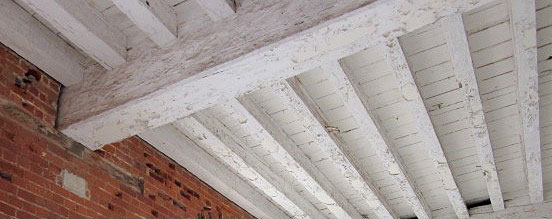There are a myriad of BS and EN standards that regulate the selection, treatment and use of timber/timber products for new buildings (and new structures within existing buildings). For all those with professions (and trades) in Europe, which involve the use of ‘regular square section structural timber’, the top trump is the “ harmonized” standard EN 14081. Out of this harmony flows a veritable root system of variables – with the exception of the strength grader stood in the wood yard who is pointed in the direction of either BS 4978 (for softwoods) or BS 5756 (for hardwoods).
With regard to the historic or existing structure, there is no standardization of insitu strength grading, which is a good thing as there is no such thing as a standard historic building. While elements of BS 4978/5756 provide useful starting points to the assignment of strength grades of insitu timber, a detailed knowledge of timber anatomy, architectural history and the ability of a grader to determine species are far more important.
For example, in the case of softwoods (most often requiring insitu strength grading), if an original floor in a Residential Georgian terrace is being assessed, it is a fair bet that the timber joists are Pinus sylvestris, almost certainly sourced in the Baltic states. If early/mid 19C or earlier the timber will pre date implementation of modern forestry techniques, so will be slow grown and therefore dense, durable (in terms of having a high percentage of fully formed heartwood) and therefore carry a standardized characteristic bending stress of C24, although in reality almost certainly capable of withstanding considerably greater loads.
(Engineering interlude: C denotes conifer, 24 denotes N/mm2 or mPa, an SI unit which brings together internal stress and pressure, elastic (or Young’s) modulus and ultimate tensile strength).
With regard to timber anatomy, while it is clear that the conglomeration of large knots and deformed or overly sloping grain significantly reduce strength, economies of transport (shipping) mean that timber such as this would not have got close to a ship bound for England anywhere between in the late 17th and the beginning of the 20th century.

So before pulling the floor up (or ceiling down) or removing all the original paint from the timbers – all of which I have seen specified for the purposes of strength grading – just take a couple of samples from a few joists. Interpolation of growth rate and species should provide all the information necessary to assign a strength grading to the timber.
Interestingly in the case of elm structures, no data has been acquired for the purposes of assigning strength characteristics. As such the only approach would be to assess the timber through its anatomy and any past or present bio-deterioration (mortises and/or swirling grain in elm can be susceptible to damage by wood borers).
Note: Definitive identification of softwood species is only possible through microscopy. It may be that timber elements are Pitch pine (blog to come) in which case it would be graded C27 as a matter of course.
